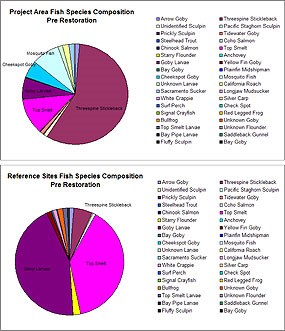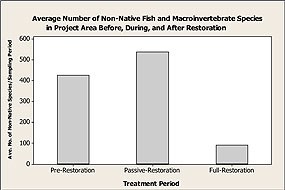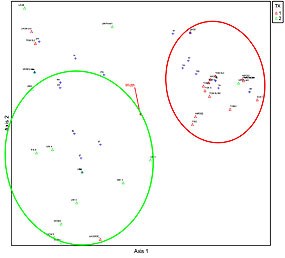
In stark contrast to zooplankton results, the composition of fish species showed strong differences between the dairy ranch and natural marshes prior to restoration. The largest difference in these areas came from the higher relative abundances or proportion of catch of sculpin, threespine stickleback (Gasterosteus aculeatus), and non-native mosquitofish (Gambusia affinis), while Reference Areas had higher relative abundances of goby larvae (Figure 9 [79 KB PDF]). In addition, Reference Areas also appeared to have higher numbers of topsmelt (Atherinops affinis), a larger fish species (Figure 9). Mosquitofish were probably introduced into the Giacomini Ranch drainage ditches and potentially creeks at some point by the ranchers to keep down mosquito numbers. Since then, they have thrived in Project Area waters with seemingly little "maintenance" or re-stocking. Despite occasional discharges of Project Area waters to outside creeks and waterways, mosquitofish have yet to establish in similarly high numbers in undiked areas, although they have been caught during sampling events. After the second year after restoration, no clear differences emerged in fish community composition in the Project Area between Pre-Restoration, Passive Restoration, and Full Restoration periods. The only clear difference in relative species abundance between these periods was in the proportion of non-native yellowfin goby (Acanthogobius flavimanus), Sacramento sucker (Catostomus occidentalis), and small, unidentified goby. Sacramento sucker and goby were characterized as having the highest relative abundance during Pre-Restoration, while the non-native yellowfin goby had the highest numbers during Passive Restoration. Species such as threespine stickleback appeared equally common or frequent between all three restoration phases, with sculpin numbers or proportion of catch highest in Passive Restoration. 
Relative numbers or proportion of mosquitofish also appeared to drop considerably after Full Restoration relative to Pre-Restoration and Passive Restoration periods, but results were not statistically significant, so this conclusion can only be considered preliminary. However, relative abundance of non-native fish and invertebrate species, including relative abundances of mosquitofish, yellowfin goby, cheekspot goby (Ilypnus gilberti), silver carp (Hypophthalmichthys molitrix), white crappie (Pomoxis annularis), and signal crayfish (Pacifastacus leniusculus), dropped considerably after restoration, particularly between pre-restoration and full restoration periods (Figure 10 [107 KB PDF]). Numbers of tidewater goby, a federally endangered brackish water fish that occurred in the Project Area even prior to restoration, did not appear to change with restoration, although relative abundance might have been highest actually during Passive Restoration. During construction, park biologists relocated tidewater goby from drainage ditches that were going to be filled to known habitat areas that were being retained such as the former diked Tomasini Creek channel and a pond at the northern end of the East Pasture. Some of the restoration effort focused on creating areas within channels and on the marshplain that would not drain during low tide to provide additional habitat for this species. In October 2009, fisheries biologists actually found tidewater goby already using some of the newly restored habitat, well ahead of the expected timeline for colonizing these new habitat areas. 
As with Pre-Restoration conditions, fish composition of the Project Area continued to differ strongly from natural marshes or Reference Areas even after Full Restoration (Figure 11 [29 KB PDF]). This occurred even if the more freshwater locations within the restored dairy were removed from analysis to make sites more comparable to natural marshes. Differences between the restored wetland and its natural marsh counterparts revolved principally around the higher relative abundance or proportion of catch of arrow goby (Clevelandia ios), goby larvae, and longjaw mudsucker (Gillichthys mirabilis) in Reference Areas and the higher relative abundance of sculpin and bay pipefish (Syngnathus leptorhynchus) in the Project Area. The number of species also did not change much with restoration or differ much between the restored dairy and natural marshes. In general, average number of species per sampling location ranged from 3.0 in the Project Area to 3.3 in the Reference Areas prior to restoration and from 3.3 in the Project Area to 3.1 in the Reference Areas after restoration. The lack of any definitive change in fish composition in the Project Area with either Passive or Full Restoration may simply be a matter of time: not enough time has passed since restoration for fish communities to change. Fish assemblages may be less plastic in terms of responding to changed conditions than zooplankton, although it did appear that relative abundance of some of the non-native species, including mosquitofish, a freshwater to weakly brackish species, may have declined with increases in salinity of Project Area waters. Threespine stickleback has always been the most abundant species in the Project Area, and this situation does not appear to have changed with restoration, at least yet. Ultimately, composition of the Project Area and Reference Area communities may never totally converge, because the Project Area will continue to be influenced much more strongly by freshwater from creek flow and abundant groundwater flow from the surrounding Point Reyes Mesa and Inverness Ridge than any of the natural marshes. Threespine stickleback can occur across a range of salinities, but its abundance is typically highest in freshwater and brackish environments, while arrow goby predominates in more saline environments. Threespine stickleback occur in much lower numbers in natural marshes, probably because of the higher range of salinities in this Study Area. Untangling the Food Web: Changes in Prey Base Following Restoration |
Last updated: June 27, 2024
